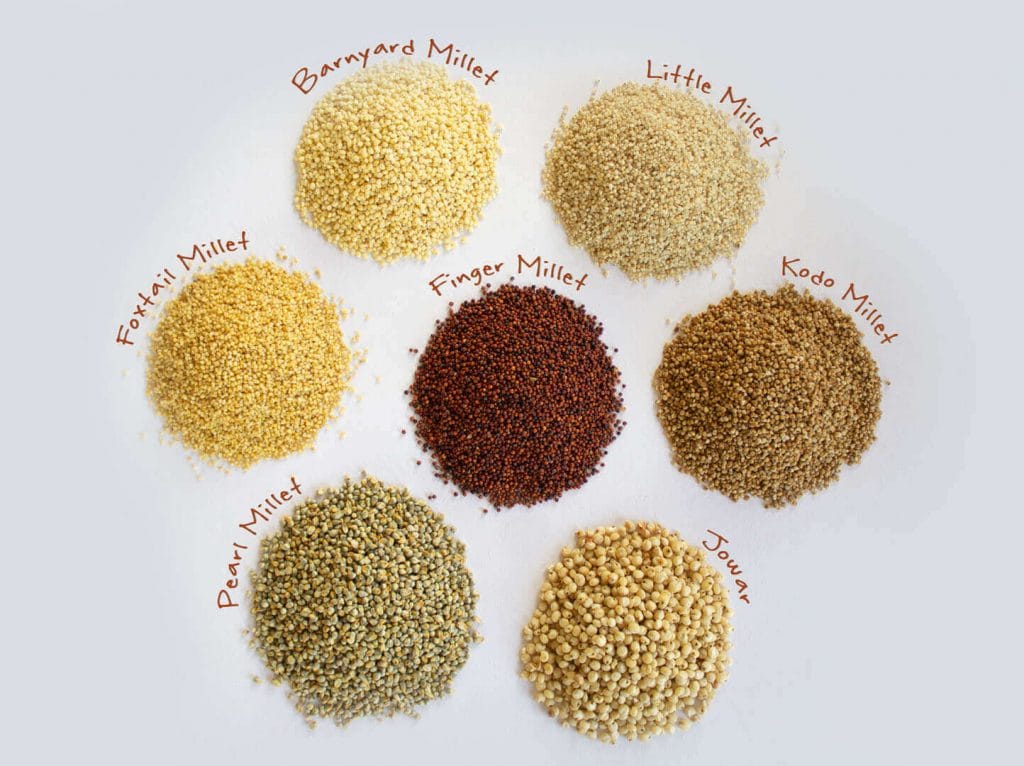In the era of avocado toast and plant-based burgers, it’s no surprise that there is a Millet Comeback. These ancient grains are experiencing a resurgence in popularity among millennials.

This humble yet versatile grain, once relegated to bird feed and forgotten pantry shelves, is now reclaiming its status as a trendy and nutritious staple in modern kitchens.
Let’s explore why millennials are embracing the millet movement with enthusiasm and how this ancient grain is making a comeback in contemporary culinary culture says Chef Sourabh, Founder of Craft of Food 2.0.
The Millet Revival: Rediscovering an Ancient Superfood
Millet, once a staple in ancient diets, is making a significant comeback in modern nutrition. This small-seeded grain, encompassing varieties like sorghum, pearl millet, and finger millet, has been cultivated for thousands of years across Asia and Africa. Today, its resurgence is driven by growing awareness of its exceptional health benefits and sustainability. Recently celebrated as the international year of millets, the grain is rich in essential nutrients, gluten-free, and resilient to harsh growing conditions, this grain is being celebrated as a powerhouse grain.
A Journey Through History and Culture
This ancient grain has a rich history, tracing back over 10,000 years to its domestication in Northern China. Archaeological discoveries reveal that it was one of the first crops farmed by early human civilizations, playing a crucial role in sustaining these communities. Its cultivation spread across Asia, Africa, and the Indian subcontinent, where it became a dietary staple due to its resilience in harsh climates and poor soil conditions.
In Africa, Millet was particularly significant in the Sahel region, where it thrived despite the semi-arid environment. It not only provided nutrition but also supported the survival of agricultural communities facing challenging growing conditions. Meanwhile, in ancient India, the millet was integrated into various aspects of life, from daily meals to religious festivals and ceremonies.
Beyond its nutritional value, this grain held cultural and spiritual importance. Ancient Chinese texts frequently mention it in the context of offerings and rituals, highlighting its role in both daily life and spiritual practices. In parts of Africa and India, it was used in traditional ceremonies, underscoring its cultural significance.
Today, this grain is experiencing a resurgence in popularity, celebrated for its health benefits and sustainability. Its enduring legacy as a staple food in various ancient civilizations underscores its historical significance and continued relevance in modern diets.
Essential Health Benefits of a Nutrient-Rich Ancient Grain
Millet is an incredibly nutrient-dense grain, rich in essential vitamins and minerals like B vitamins, calcium, iron, potassium, zinc, magnesium, and dietary fibre. These nutrients play crucial roles in maintaining overall health, from boosting energy levels to promoting healthy bones and teeth. Additionally, the grain is beneficial for heart health due to its high magnesium and fibre content, which help lower blood pressure and cholesterol levels, ultimately supporting cardiovascular well-being.
For those managing diabetes, this grain is an excellent dietary choice because of its low glycemic index, which helps regulate blood sugar levels. Its high fibre content also aids digestion, preventing common issues like constipation, bloating, and cramping. Regular consumption of millet promotes a healthy digestive system and improves nutrient absorption.
Moreover, it is packed with phenolic compounds and antioxidants such as quercetin and curcumin. These antioxidants help combat oxidative stress, reducing the risk of chronic diseases like cancer, cardiovascular diseases, and diabetes. Including millet in your diet is a smart way to enhance your health while supporting sustainable agriculture.
Health and Wellness Trends
Millennials are known for their commitment to health-conscious lifestyles, and the millet fits perfectly into this ethos. As a gluten-free whole grain, this grain is rich in nutrients like fibre, protein, vitamins, and minerals, making it a nourishing choice for those seeking wholesome and balanced diets. With growing concerns about food sensitivities and digestive health, this grain offers a gentle alternative to wheat and other gluten-containing grains, making it a favourite among millennials with dietary restrictions.
Sustainability and Environmental Consciousness
In an age where sustainability is paramount, millennials are gravitating towards foods that are not only good for their bodies but also for the planet. Millet is a sustainable crop that requires minimal water and resources to grow, making it an eco-friendly choice for environmentally conscious consumers.
By supporting the production and consumption of millet, millennials are contributing to sustainable agriculture practices and reducing their carbon footprint—an important consideration in today’s increasingly eco-conscious world.
Culinary Versatility and Innovation
Millennials are known for their adventurous palates and willingness to experiment with new flavours and ingredients. The Millet’s mild flavour and versatile texture make it a blank canvas for culinary creativity, inspiring chefs and home cooks alike to explore innovative ways of incorporating this ancient grain into their dishes.
From fluffy breakfast porridges and hearty grain bowls to crispy veggie burgers and gluten-free baked goods, millet lends itself to a wide range of culinary applications, appealing to millennials’ appetite for variety and novelty in their meals.
Global Cuisine Appreciation
Millennials are passionate about exploring diverse cultures and cuisines, seeking out authentic and exotic flavours from around the world. This grain, a staple ingredient in many traditional cuisines, offers millennials an opportunity to expand their culinary horizons and experience the rich diversity of global food traditions.
Whether enjoying Indian khichdi, African injera, or Chinese congee, millennials are embracing millet as a gateway to exploring the vibrant tapestry of global cuisine, fostering cultural appreciation and culinary diversity in the process.
Culinary Delights with Millet
This versatile grain is a popular choice for both traditional and contemporary recipes. It can be used to prepare hearty breakfast porridges, much like oatmeal, providing a nutritious start to the day. Millet flour is excellent for baking gluten-free bread, muffins, and pancakes, offering a healthier alternative to refined flour.
In savoury dishes, it can be cooked as a base for grain bowls, salads, or used in place of rice or couscous in pilafs and stir-fries. It can also be included in soups and stews, adding a unique texture and enhancing nutritional content. For a snack, puffed millet can be used to make energy bars or mixed with nuts and dried fruits for a wholesome trail mix. It can be stuffed into bell peppers with vegetables and spices for a hearty meal, or formed into patties for healthy millet burgers.
South Indian cuisine incorporates this grain into dishes like upma, a savoury breakfast dish cooked with mustard seeds, curry leaves, and vegetables, and dosa, a crispy crepe made from fermented millet batter. For a Middle Eastern twist, this grain can be used in tabouleh, a refreshing salad with parsley, mint, tomatoes, and cucumbers.
Millet Risotto provides a healthy twist on the classic Italian dish by using this grain instead of Arborio rice, resulting in a creamy and flavorful risotto. Similarly, Millet Pilaf is a savoury dish where millet is cooked with a mix of vegetables, herbs, and spices, creating a nutritious and tasty meal akin to traditional rice pilaf.
This grain also lends itself well to sweet dishes. It can be simmered with milk, sweeteners, and spices to create a comforting pudding, or used to make fluffy pancakes for a nutritious breakfast.
Convenience and Time-Saving Solutions
In today’s fast-paced world, millennials are constantly seeking convenient and time-saving solutions to meet their dietary needs. Millet, with its quick cooking time and versatility, fits seamlessly into the busy lifestyles of millennials on the go.
Whether preparing a quick weeknight meal or meal prepping for the week ahead, this grain’s ease of preparation and adaptability make it a convenient choice for millennials looking to nourish themselves with wholesome and satisfying foods without sacrificing taste or quality.

In conclusion, the millet movement is gaining momentum among millennials for a variety of reasons—from its health benefits and sustainability credentials to its culinary versatility and global appeal. As this ancient grain continues to capture the imagination of a new generation of food enthusiasts, it’s clear that millet is more than just a passing trend—it’s a symbol of the evolving tastes, values, and priorities of millennial consumers.
So, whether enjoyed in a hearty grain bowl, savoury pilaf, or decadent dessert, millet is poised to remain a cherished staple in the modern millennial pantry for years to come.
Fun Facts About Millet
Did you know that millet was a staple food for the ancient Chinese more than 10,000 years ago? This resilient grain was even mentioned in the oldest known Chinese agriculture book, “The Book of Songs”!
Millet was also a crucial part of the ancient Egyptian diet and has been found in tombs, indicating its importance in their culture and as a source of sustenance for the afterlife.
Millet is not just for humans; it is a popular ingredient in birdseed mixes, providing essential nutrients to both wild and domesticated birds.
Apart from being used as food, millet is also employed in brewing beer in some African countries and making traditional alcoholic beverages.
About the author: Chef Sourabh, Founder of Craft of Food 2.0
Read more: Latest



